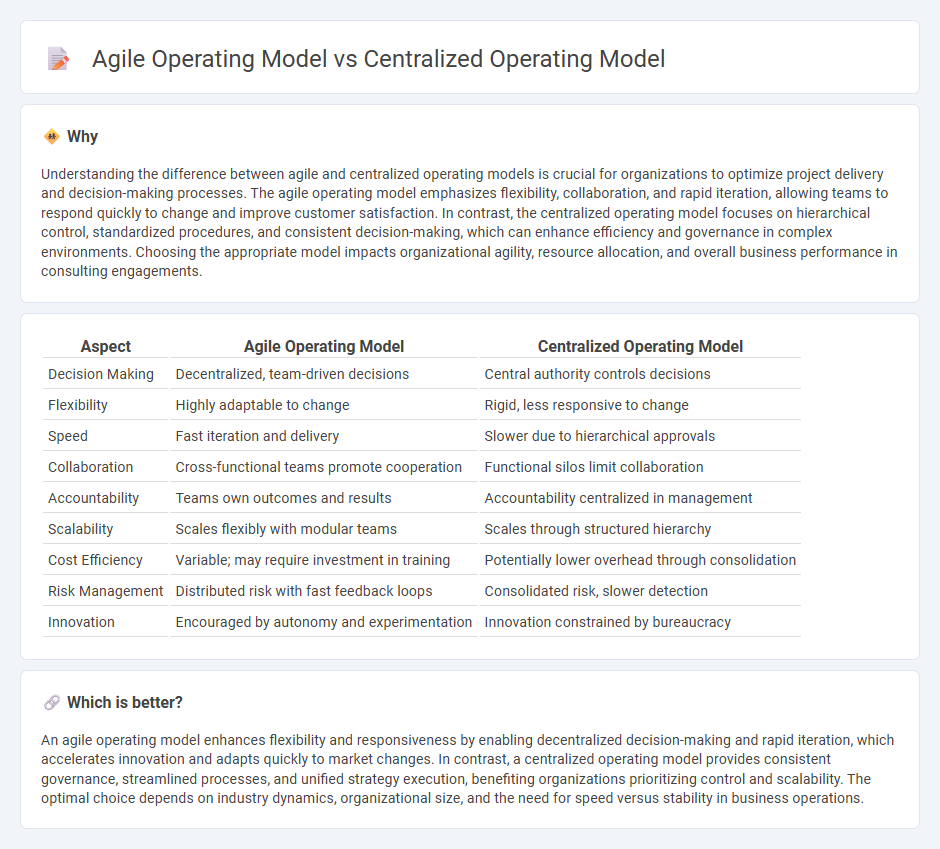
An agile operating model emphasizes flexibility, rapid decision-making, and cross-functional collaboration to respond swiftly to market changes, contrasting with the centralized operating model's focus on standardized processes, hierarchical decision-making, and consistency across the organization. Agile models often improve innovation speed and customer responsiveness, while centralized models enhance control, efficiency, and resource consolidation. Explore the advantages and applications of these operating models to determine the best fit for your organizational goals.
Why it is important
Understanding the difference between agile and centralized operating models is crucial for organizations to optimize project delivery and decision-making processes. The agile operating model emphasizes flexibility, collaboration, and rapid iteration, allowing teams to respond quickly to change and improve customer satisfaction. In contrast, the centralized operating model focuses on hierarchical control, standardized procedures, and consistent decision-making, which can enhance efficiency and governance in complex environments. Choosing the appropriate model impacts organizational agility, resource allocation, and overall business performance in consulting engagements.
Comparison Table
| Aspect | Agile Operating Model | Centralized Operating Model |
|---|---|---|
| Decision Making | Decentralized, team-driven decisions | Central authority controls decisions |
| Flexibility | Highly adaptable to change | Rigid, less responsive to change |
| Speed | Fast iteration and delivery | Slower due to hierarchical approvals |
| Collaboration | Cross-functional teams promote cooperation | Functional silos limit collaboration |
| Accountability | Teams own outcomes and results | Accountability centralized in management |
| Scalability | Scales flexibly with modular teams | Scales through structured hierarchy |
| Cost Efficiency | Variable; may require investment in training | Potentially lower overhead through consolidation |
| Risk Management | Distributed risk with fast feedback loops | Consolidated risk, slower detection |
| Innovation | Encouraged by autonomy and experimentation | Innovation constrained by bureaucracy |
Which is better?
An agile operating model enhances flexibility and responsiveness by enabling decentralized decision-making and rapid iteration, which accelerates innovation and adapts quickly to market changes. In contrast, a centralized operating model provides consistent governance, streamlined processes, and unified strategy execution, benefiting organizations prioritizing control and scalability. The optimal choice depends on industry dynamics, organizational size, and the need for speed versus stability in business operations.
Connection
An agile operating model enhances flexibility and responsiveness by decentralizing decision-making, enabling teams to adapt quickly to market changes. A centralized operating model, by contrast, consolidates control and standardizes processes to ensure consistency and efficiency across the organization. Integrating agile principles within a centralized operating model balances rapid innovation with governance, driving optimized performance and strategic alignment.
Key Terms
Decision-Making Authority
Centralized operating models concentrate decision-making authority at the top leadership level, ensuring uniformity and control across the organization. Agile operating models distribute decision-making power to cross-functional teams, enhancing flexibility and rapid response to market changes. Explore how these models impact organizational performance and adaptability in dynamic business environments.
Flexibility
Centralized operating models streamline decision-making through hierarchical structures, enhancing control but limiting flexibility in rapidly changing environments. Agile operating models prioritize adaptability and iterative processes, enabling quicker responses to market shifts and customer demands. Explore how choosing the right operating model can transform your organization's flexibility and performance.
Hierarchical Structure
The centralized operating model relies on a rigid hierarchical structure with clear lines of authority and decision-making concentrated at the top levels, enabling consistent control and streamlined processes. The agile operating model promotes a flexible hierarchy, empowering cross-functional teams and decentralized decision-making to adapt rapidly to market changes. Discover how organizations balance control and responsiveness by exploring these structural differences in depth.
Source and External Links
Centralized vs. Decentralized Operations: Which Model Drives Better Outcomes? - A centralized operating model consolidates decision-making and core functions under unified leadership to provide streamlined control, consistent processes, and standardized decision-making across an organization, benefiting industries needing uniformity and compliance but potentially limiting agility and responsiveness.
Centralized vs Federated Digital Data Transformations - In a centralized operating model, a single team or center of excellence is responsible for planning, execution, and standardization of data processes, which improves consistency, efficient project management, and scalability but can create bottlenecks and reduce autonomy across departments.
The pros and cons of the centralized enterprise automation operating model - The centralized model delegates enterprise automation responsibilities to a central team that handles strategy, tool selection, and solutions delivery, optimizing technology use and skills concentration but often suffering from a lack of agility.
 dowidth.com
dowidth.com